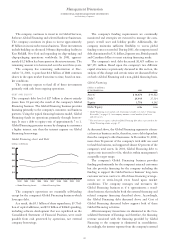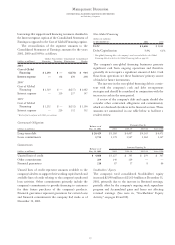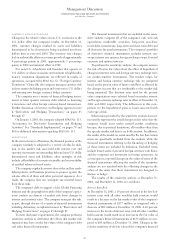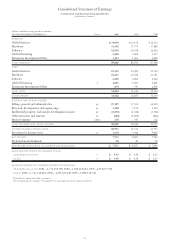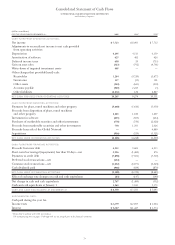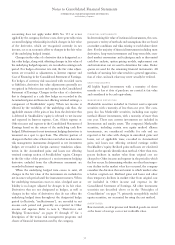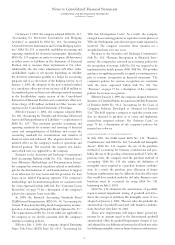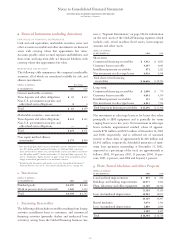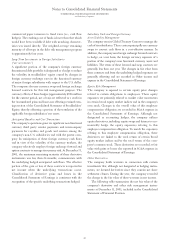IBM 2001 Annual Report Download - page 78
Download and view the complete annual report
Please find page 78 of the 2001 IBM annual report below. You can navigate through the pages in the report by either clicking on the pages listed below, or by using the keyword search tool below to find specific information within the annual report.
Notes to Consolidated Financial Statements
INTERNATIONAL BUSINESS MACHINES CORPORATION
and Subsidiary Companies
76
delivered prior to others in an arrangement, revenue is
deferred until the delivery of the last element unless there is
all of the following:
•Vendor-specific objective evidence of fair value (VSOE) of
the undelivered elements.
•The functionality of the delivered elements is not dependent
on the undelivered elements.
•Delivery of the delivered element represents the culmina-
tion of the earnings process.
VSOE is the price charged by the company to an external
customer for the same element when such element is
sold separately.
EXPENSE AND OTHER INCOME
Selling, General and Administrative
Selling, general and administrative (SG&A) expense is
charged to income as incurred. Expenses of promoting and
selling products are classified as selling expense and include
such items as advertising, sales commissions and travel.
General and administrative expense includes such items as
officers’ salaries, office supplies, non income taxes, insurance
and office rental. In addition, general and administrative
expense includes other operating items such as provision for
doubtful accounts, workforce accruals for contractually obli-
gated payments to employees terminated in the ongoing
course of business, amortization of intangible assets and
environmental remediation costs. The cost of internal envi-
ronmental protection programs that are preventive in nature
are expensed as incurred. The company accrues for all
known environmental liabilities when it becomes probable
that the company will incur cleanup costs and those costs can
be reasonably estimated. In addition, estimated environmen-
tal costs that are associated with post-closure activities (for
example, the removal and restoration of chemical storage
facilities and monitoring) are accrued when the decision is
made to close a facility.
Research, Development and Engineering
Research, development and engineering costs are expensed
as incurred.
Intellectual Property and Custom Development Income
As part of the company’s ongoing business model, the com-
pany licenses and sells the rights to certain of its intellectual
property including internally developed patents, trade
secrets and technological know-how. Certain transfers of
intellectual property to third parties are licensing/royalty fee
based and other transfers are transaction-based sales and
other transfers. Licensing/royalty-based fees involve transfers
in which the company earns the income over time or the
amount of income is not fixed and determinable until the
licensee sells future related products (e.g., variable royalty
based upon licensee’s revenue). Sales and other transfers
typically include transfers of intellectual property whereby
the company has fulfilled its obligations and the fee received
is fixed and determinable. The company also earns income
from certain custom development projects for specific
customers. The company records the income from these
projects when the fee is earned, is not refundable, and is not
dependent upon the success of the project.
Other Income and Expense
Other income and expense includes interest income (other
than from the company’s Global Financing business transac-
tions), gains and losses from securities and other investments,
realized gains and losses from real estate activity, and foreign
currency transaction gains and losses.
Depreciation and Amortization
Plant, rental machines and other property are carried at cost
and depreciated over their estimated useful lives using the
straight-line method.
The estimated useful lives of depreciable properties gen-
erally are as follows: buildings, 50 years; building equipment,
20 years; land improvements, 20 years; plant, laboratory and
office equipment, 2 to 15 years; and computer equipment,
1.5 to 5 years.
Capitalized software costs incurred or acquired after
technological feasibility are amortized over periods up to 3
years. See “Software Costs” section on page 79 for additional
information. Other intangible assets are amortized for periods
up to 5 years. See “New Standards to Be Implemented” on
pages 80 and 81 for additional information on goodwill.
Retirement-Related Benefits
The company accounts for its defined benefit pension plans
and its nonpension postretirement benefit plans using actu-
arial models required by Statement of Financial Accounting
Standards (SFAS) No. 87, “Employers’ Accounting for
Pensions,” and SFAS No. 106, “Employers’ Accounting for
Postretirement Benefits Other Than Pensions,” respectively.
These models use an attribution approach that generally
spreads individual events over the service lives of the employ-
ees in the plan. Examples of “events” are plan amendments
and changes in actuarial assumptions such as discount rate,
rate of compensation increases and mortality. See the next
paragraph for information on the expected long-term rate of
return on plan assets. The principle underlying the required
attribution approach is that employees render service over
their service lives on a relatively smooth basis and therefore,
the income statement effects of pensions or nonpension
postretirement benefit plans are earned in, and should follow,
the same pattern.


